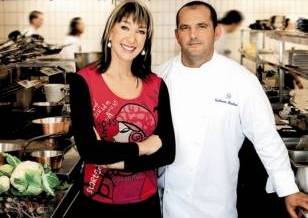 Food Safari, the ultimate food lover’s feast, returns with a spectacular new French inspired, nine-part series. French Food Safari is a celebration of exquisite French cuisine in all its delicious complexity, filmed around Australia and France.
Food Safari, the ultimate food lover’s feast, returns with a spectacular new French inspired, nine-part series. French Food Safari is a celebration of exquisite French cuisine in all its delicious complexity, filmed around Australia and France.
Presented by Maeve O’Meara, French Food Safari follows one of France’s best exports to Australia, top chef Guillaume Brahimi—owner and chef at the renowned Bennelong Restaurant under the sails of the Sydney Opera House—on a personal voyage. They visit many of France’s top kitchens and the many places of food pilgrimage in both Paris and regional France–tracking down world-renowned butter, cheese, chocolate, charcuterie, truffles and wine.
French Food Safari is a Who’s Who of France’s top French chefs and providores (purveyors/providers of food) including acclaimed Alain Ducasse, who has 27 restaurants across the world and an unprecedented 19 Michelin stars, the father of modern French cooking Paul Bocuse, legendary chef Guy Savoy, who has restaurants in Paris, Las Vegas and Singapore, and the incomparable king of sweets Pierre Hermé.
French Food Safari also gains access to the elusive rock star of bread Jean-Luc Poujaran, who works in an ancient cellar below the streets of Paris; plus the wood-fired oven of baker Poilâne, whose bread is flown daily to New York and Tokyo; there is an extensive, and of course delicious, tasting of some of France’s best cheeses with affineur Laurent Dubois; and a visit to the labyrinthine tunnels in which Champagne’s finest bottles mature.
The series also explores the beautifully aromatic world of Maison du Chocolat where oceans of liquid chocolate are transformed into exquisite sweet delights.
Australia’s crème de la crème of French-inspired chefs also feature in this mouth-watering series, sharing their wisdom and recipes, including Shannon Bennett (Vue du Monde), Philippe Mouchel (pm24), Warren Turnbull (Assiette, District Dining), Mark Best (Marque), Jacques Reymond (Jacques Reymond’s Cuisine du Temps), Serge Dansereau (Bathers Pavillion), Chui Lee Luk (Claude’s), Tony Bilson (Bilson’s), Damien Pignolet (Bistro Moncur), Geraud Fabre (France Soir), Robert Molines (Bistro Molines), Gabriel Martin (Metropolis), Romeo Baudouin (Victor Churchill), Vincent Gadan (Patisse), and Pierrick Boyer (Le Petit Gâteau).
These leaders of French cookery share some of their favorite recipes, many of which are within range of home cooks. Learn how to create classics such as coq au vin, boeuf en croûte, vol-au-vent, salad niçoise, chicken grenobloise, terrine, croquembouche, soufflé and flan. As well, Guillaume Brahimi shares some of his own spectacular recipes for bouillabaisse, cassoulet, ratatouille, crème brulée and raspberry tart.
Click here for the recipes featured in this episode.
About France
France, officially the French Republic, is a unitary semi-presidential republic in Western Europe with several overseas territories and islands located on other continents and in the Indian, Pacific, and Atlantic oceans. France is linked to the United Kingdom by the Channel Tunnel, which passes underneath the English Channel It is the largest west-European country.
Over the past 500 years, France has been a major power with strong cultural, economic, military and political influence in Europe and in the world. During the 17th and 18th centuries, France colonized great parts of North America and South Asia; during the 19th and early 20th centuries, France built the second largest empire of the time, including large portions of North, West and Central Africa, Southeast Asia, and many Caribbean and Pacific Islands.
Ancient & Medieval France:
The History of France goes back to the arrival of the earliest human being in what is now France. The Neatherthals arrived to the area hundreds of thousands years ago, while the first modern humans (Homo sapiens), the Cro-Magnons, arrived around 40,000 years ago. A number of important archaeological sites have been discovered in the country, testifying to continuous habitation by modern humans from the Upper Palaeolithic.
The first historical records appear in the Iron Age, when what is now France made up the bulk of the region known as Gaul to the ancient Greeks and Romans. The borders of modern France are approximately the same as those of ancient Gaul, which was inhabited by Celtic Gauls. Gaul was then a prosperous country of which the southernmost part was heavily subject to Greek and Roman influences.
According to Professor John T. Koch and others, France in the Late Bronze Age was part of a maritime trading-networked culture called the Atlantic Bronze Age that also included Ireland, Britain, Spain and Portugal where the Celtic languages developed. However, this stands in contrast to the more generally accepted view that Celtic origins lie with the Hallstatt culture. The Hallstatt culture was the predominant Central European culture from the 8th to 6th centuries BC (European Early Iron Age), developing out of the Urnfield culture of the 12th century BC (Late Bronze Age) and followed in much of Central Europe by the La Tène culture.
Around 390 BC, the Gallic chieftain Brennus made his own way through the Alps, defeated the Romans in the Battle of the Allia and besieged and ransomed Rome. The Gauls would continue to harass the region until 345 BC, when they entered into a formal treaty with Rome. But Romans and Gauls would maintain an adversarial relationship for the next several centuries and the Gauls would remain a threat in Italia.
The Roman Republic began its takeover of Celtic Gaul in 121 BC, when it conquered and annexed the southern reaches of the area. Julius Caesar completed the task by defeating the Celtic tribes in the Gallic Wars of 58-51 BC and the romanization that ensued was quickest in the cities; Latin was spoken by a majority of Gauls in the third century AD but with some remains of the Gallic language. Afterwards a Gallo-Roman culture emerged and Gaul was increasingly integrated into the Roman Empire. Roman Gaul consisted of modern day France, Belgium, Luxembourg, and western Germany. Roman control of the area lasted for less than 500 years.
Theodosius I was the last Emperor who ruled over the whole Empire. As emperor, he made Christianity the official religion of the Roman Empire. After his death in 395 AD, he gave the two halves of the Empire to his two sons Arcadius and Honorius. The Roman state would continue to have two different emperors with different seats of power throughout the 5th century.
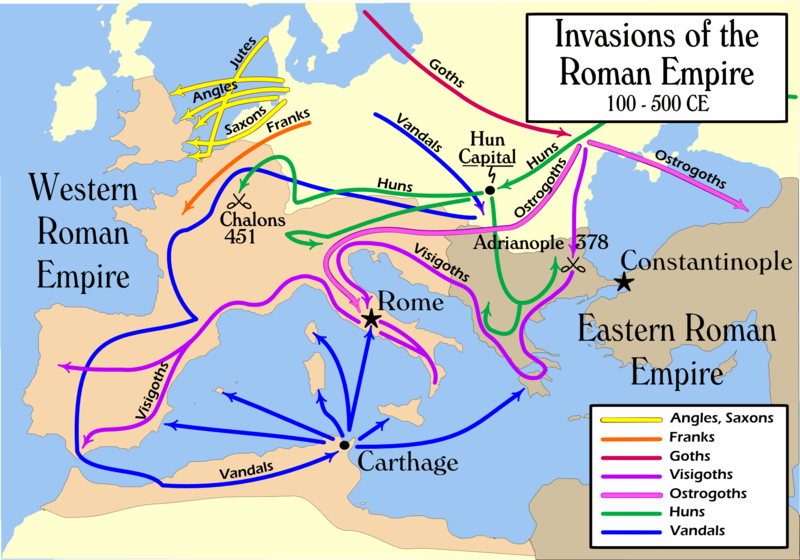 In early 407 AD, Germanic tribes, such as the Vandals, Suebi and Alans had already invaded Gaul en masse and, meeting little resistance, proceeded to cross the Pyrenees, entering Spain in 409 AD. They were soon followed by invading Goths (namely the Visigoths and the Ostrogoths) who also settled in Gaul (412–418).
In early 407 AD, Germanic tribes, such as the Vandals, Suebi and Alans had already invaded Gaul en masse and, meeting little resistance, proceeded to cross the Pyrenees, entering Spain in 409 AD. They were soon followed by invading Goths (namely the Visigoths and the Ostrogoths) who also settled in Gaul (412–418).
Thus, by the time of the final collapse of the Western Empire, it had already become less Romanized and increasingly Germanic in nature. So when General Orestes, in 476, refused the request of Germanic mercenaries in his service for lands in Italy and the dissatisfied mercenaries, led by Odoacer, revolted, the overthrow of the last western Emperor Romulus Augustus was carried out by federated Germanic troops from within the Roman army rather than by foreign troops.
The last vestige of Roman rule was effaced by the Germanic Franks at the Battle of Soissons (486), led by the Frankish king Clovis I. Clovis I was the first King of the Franks to unite all the Frankish tribes under one ruler. He was also the first Catholic King to rule over Gaul (France). After displacing the Visigothic kingdom of Toulouse in 507, the Franks brought most of Gaul, save Septimania in the south, under the rule of the Merovingians, the first kings of France. Frankish power later reached its fullest extent under Charlemagne.
Western Europe then entered into what some have called "Dark Ages"—the period of cultural and economic deterioration between the fall of Rome and the Renaissance. Several states claimed to be the Roman Empire's successors after the fall of the Western Roman Empire. The Holy Roman Empire, an attempt to resurrect the Empire in the West, was established in 800 when Pope Leo III crowned Frankish King Charlemagne as Roman Emperor.
 The medieval Kingdom of France emerged out of the western part of Charlemagne's Carolingian Empire, known as West Francia, and achieved increasing prominence under the rule of the House of Capet, founded by Hugh Capet in 987. While East Francia would later become the Kingdom of Germany and Middle Francia would later become the Kingdom of Italy, Burgundy, and Provence.
The medieval Kingdom of France emerged out of the western part of Charlemagne's Carolingian Empire, known as West Francia, and achieved increasing prominence under the rule of the House of Capet, founded by Hugh Capet in 987. While East Francia would later become the Kingdom of Germany and Middle Francia would later become the Kingdom of Italy, Burgundy, and Provence.
A succession crisis following the death of the last Capetian monarch in 1337 led to the series of conflicts, known as the Hundred Years War of 1337–1453, between the House of Valois and the House of Plantagenet.
Joan of Arc led the French army to several important victories during the Hundred Years' War which paved the way for the final victory The wars ended with a Valois victory in 1453, solidifying the power of the Ancien Régime as a highly centralized absolute monarchy
Back to Menu  |
Modern France:
During the next centuries, France experienced the Renaissance and the Protestant Reformation, as well as recurring religious conflicts and wars with other powers: the Italian Wars, the French Wars of Religion, and the War of the Three Henrys.
France was expansive during all but the end of the 17th century: the French began trading in India and Madagascar, founded Quebec and penetrated the North American Great Lakes and Mississippi, established plantation economies in the French West Indies and Saint-Domingue (present day Haiti), and extended their trade contacts in the Levant and enlarged their merchant marine.
In the late 18th century, the influences of the French Enlightenment, the growing costs of the American War of Independence that France entirely supported, the rise of political awareness and the bourgeois need of political empowerment culminated in the monarchy and associated institutions being overthrown in the French Revolution, which forever changed French and world history.
The country was governed for a period as a Republic, until the French Empire was declared by Napoleon Bonaparte. Following Napoleon's defeat in the Napoleonic Wars, France went through several further regime changes, being ruled as a monarchy, then briefly as a republic, and then as a Second Empire, until a more lasting Third French Republic was established in 1870.
France was one of the Triple Entente powers in World War I, fighting alongside the United Kingdom, Russia, and their allies against the Central Powers. It was one of the Allied Powers in World War II, but was conquered by Nazi Germany within two months. The Third Republic was dismantled, and most of the country was controlled directly by the Axis Powers, while the south was controlled by the collaborationist Vichy government.
Following liberation, a Fourth Republic was established; this was succeeded by the French Fifth Republic in 1958, the country's current government. After the war, decolonization saw most of the French colonial empire become independent, while other parts were incorporated into the French state as overseas departments and collectivities.
Economy & Geopolitics:
Today, France has its main ideals expressed in the 1789 Declaration of the Rights of Man and of the Citizen. The French Republic is defined as indivisible, secular, democratic and social by its constitution.
France is one of the world's most developed countries and possesses the world's fifth largest and Europe's second largest economy by nominal GDP. France is the wealthiest European (and the world's 4th) nation in aggregate household wealth. France enjoys a high standard of living as well as a high public education level, and has also one of the world's highest life expectancies. France has been listed as the world's "best overall health care" provider by the World Health Organization.
France has the world's third largest nominal military budget, the third largest military in NATO and EU's largest army. France also possesses the third largest nuclear weapons stockpile in the world—with ~300 active warheads as of 25 May 2010—and the world's second largest diplomatic corps (second only to that of the United States).
France is a founding member of the United Nations, one of the five permanent members of the UN Security Council, and a member of the Francophonie, the G8, G20, NATO, OECD, WTO, and the Latin Union. It is also a founding and leading member state of the European Union and the largest one by area. In 2010, France was listed 14th on the Human Development Index and 24th on the Corruption Perceptions Index.
Demographics:
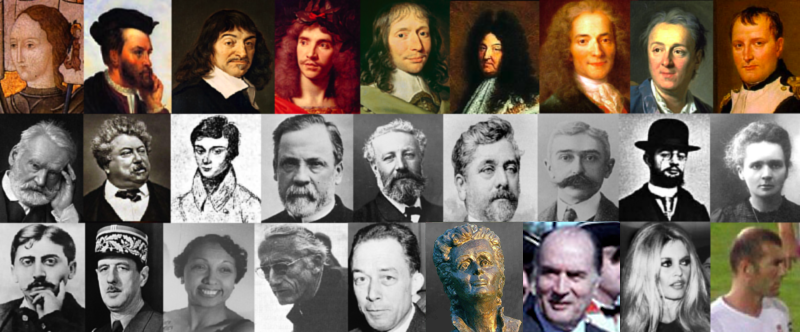 With an estimated population of 65.8 million people in 2011, France is the 20th most populous country in the world. The largest cities in France, in terms of metropolitan area population, are Paris (11.8 million), Lyon (1.76 million), Marseille (1.62 million), Lille (1.16 million), Toulouse (1.12 million), Bordeaux (1.01 million) and Nice (1.0 million). It is illegal for the French state to collect data on ethnicity and race, a law with its origins in the 1789 revolution and reaffirmed in the constitution of 1958. While official data on the size of the country's ethnic minorities is not available, it has been estimated that between three million and six million people are of North African ancestry while an estimated 2.5 million people are of Black African ancestry.
With an estimated population of 65.8 million people in 2011, France is the 20th most populous country in the world. The largest cities in France, in terms of metropolitan area population, are Paris (11.8 million), Lyon (1.76 million), Marseille (1.62 million), Lille (1.16 million), Toulouse (1.12 million), Bordeaux (1.01 million) and Nice (1.0 million). It is illegal for the French state to collect data on ethnicity and race, a law with its origins in the 1789 revolution and reaffirmed in the constitution of 1958. While official data on the size of the country's ethnic minorities is not available, it has been estimated that between three million and six million people are of North African ancestry while an estimated 2.5 million people are of Black African ancestry.
France is a secular country, and freedom of religion is a constitutional right. The French government does not keep statistics on religious adherence, nor on ethnicity or on political affiliation. Roman Catholicism, the religion of a majority of French people, is no longer considered a state religion, as it was before the 1789 Revolution and throughout the various, non-republican regimes of the 19th century (the Restoration, the July Monarchy and the Second French Empire). Other major religions in France include Islam, Judaism, Russian Orthodoxy, and Armenian Christianity amongst others, making it a multiconfessional country. However, religious observance nowadays is generally low.
France, and in particular Paris, has played an important role as a center of high culture and of decorative arts since the seventeenth century, first in Europe, and from the nineteenth century on, world wide. From the late nineteenth century, France has also played an important role in cinema, fashion and cuisine. The importance of French culture has waxed and waned over the centuries, depending on its economic, political and military importance. French culture today is marked both by great regional and socioeconomic differences and by strong unifying tendencies.
Tourism:
France attracted 78.95 million foreign tourists in 2010, making it the most popular tourist destination in the world, largely thanks to the numerous cultural establishments and historical buildings implanted all over the territory. It counts 1,200 museums welcoming more than 50 million people annually.
The most important cultural sites are run by the government, for instance through the public agency Centre des monuments nationaux, which have around a hundred national historical monuments at charge. The 43,180 buildings protected as historical monuments include mainly residences (many castles, or châteaux in French) and religious buildings (cathedrals, basilicas, churches, etc.), but also statutes, memorials and French gardens. The UNESCO inscribed 37 sites in France on the World Heritage List.
Paris, the capital city, is the most visited city in the world. Paris attracts tourists with museums such as the Louvre and Musée d'Orsay, and attractions like the Eiffel Tower, Arc de Triomphe, the cathedral of Notre-Dame, and Disneyland Paris. With more than 10 millions tourists a year, the French Riviera (or Côte d'Azur), in south-eastern France, is the second leading tourist destination in the country, after the Parisian region.
Other top popular tourist attractions include: Palace of Versailles, Centre Pompidou, Mont-Saint-Michel, Château de Chambord, Sainte-Chapelle, Château du Haut-Kœnigsbourg, Puy de Dôme, Musée Picasso, and Carcassonne. In the eastern parts of France there are skiing resorts in the Alps.
French Cuisine
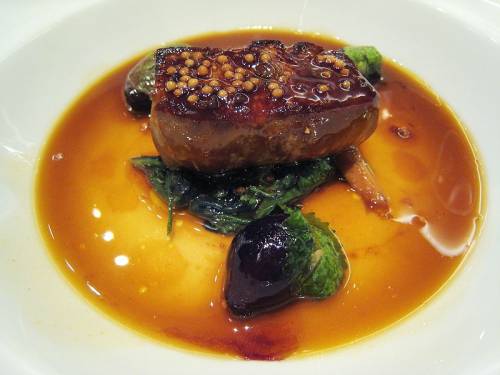 French cuisine is a style of cooking originating from France, that has developed from centuries of social and political change. Cheese and wine are a major part of the cuisine, playing different roles regionally and nationally, with many variations. Knowledge of French cooking has contributed significantly to Western cuisines and its criteria are used widely in Western culinary education. In November 2010 the French Gastronomy was added by UNESCO to its lists of the world's "intangible cultural heritage".
French cuisine is a style of cooking originating from France, that has developed from centuries of social and political change. Cheese and wine are a major part of the cuisine, playing different roles regionally and nationally, with many variations. Knowledge of French cooking has contributed significantly to Western cuisines and its criteria are used widely in Western culinary education. In November 2010 the French Gastronomy was added by UNESCO to its lists of the world's "intangible cultural heritage".
There are many French dishes that are considered part of the nation's national cuisine today. Many come from haute cuisine in the fine-dining realm, but others are regional dishes that have become a norm across the country.
The national cuisine started forming in the Middle Ages due to the influence of the work of skilled chefs and various social and political movements. The national cuisine developed primarily in Paris with the chefs to French royalty, but eventually it spread throughout the country and was even exported overseas.
French regional cuisine is characterized by its extreme diversity and style. Traditionally, each region of France has its own distinctive cuisine accepted by both its bourgeoisie and general citizenry of the regions.
Produce:
French regional cuisines use locally grown vegetables, such as pomme de terre (potato), haricot verts (a type of French green bean), carotte (carrot), poireau (leek), navet (turnip), aubergine (eggplant), courgette (zucchini), and échalotte (shallot). It also uses locally grown fungii, such as truffe (truffle), champignon de Paris (mushroom), chanterelle ou girolle (chanterelle), pleurote (en huître) (oyster mushrooms), and cèpes (porcini).
Common fruits include oranges, tomatoes, tangerines, peaches, apricots, apples, pears, plums, cherries, strawberries, raspberries, redcurrant, blackberries, grapes, grapefruit, and blackcurrants.
Meat & Seafood:
Varieties of meat consumed include poulet (chicken), pigeon (squab), dinde (turkey), canard (duck), oie (goose, the source of foie gras), bœuf (beef), veau (veal), porc (pork), agneau (lamb), mouton (mutton), lapin (rabbit), caille (quail), cheval (horse), grenouille (frog), and escargot (snails).
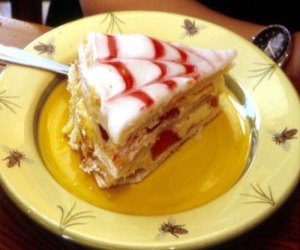
Commonly consumed fish and seafood include cod, canned sardines, fresh sardines, canned tuna, fresh tuna, salmon, trout, mussels, herring, oysters, shrimp and calamari.
Deserts:
The French are actually not big dessert eaters, which is surprising since they offer an incredible repertoire of famous French desserts. However, ranging from simple fare to complicated confections, French desserts are something to be savored slowly.
Common desserts include: mousse au chocolat, crème brûlée, mille-feuilles, choux à la crème (cream puffs, see choux pastry), tartes aux fruits (fruit tarts), religieuse (chocolate éclair shaped to resemble a nun), madeleine (a small cake-like cookie), tarte tatin (caramelized apple tart), gâteaux (cake), éclairs, and profiteroles (baked puff pastries (choux) filled with cream or confectioner's cream).
Beverages:
In French cuisine, beverages that start a meal are called apéritif. Those who end it are called digestif. Apéritifs are generally dry and are perfect to open a meal: Suze, Calvados, Armagnac, but also Kir, Champagne and sometimes mild alcoholic drink like crèmes.
During the courses wines will perfectly marry with the diversity of French cuisine. Rosé are tasty, fruity and soft so that they can accompany many dishes, the dry rosé will sustain salads at the beginning (e.g.: Tavel) and the mild Rosé may also accompany fruits salads, tartes aux fruits and light sugared or subtiles dessert like a crème brûlée. Dry white wines commonly marry well with sea food like Alsace, Sauvignon. Red wines are perfect with meats and moreover with red meats, and also cheese. For examples Bordeaux, Bourgogne, Merlot, Anjou. Mild sugared wines will be advantages with most of the desserts, among them Sauternes, Coteaux du Layon, but also champagne brut.
Water will replace wines as for clearing the palate from tastes in between the dishes. Sparkling waters are appreciated in big meal for their digestives properties: Badoit is generally considered as a good eau de table. To finish the meal liquors or liquorous wines are welcome (for example grand Marnier, also Cognacs and why not champagne again as many will find a way to bring a toast again.
Episodes:
 |
AFRICAN: Wherever you are in Africa, no meal is complete without a starchy porridge known as fufu. |
 |
BRAZILIAN: An exuberant, colorful mix of Portuguese, African and native foods including some from the Amazon. |
 |
CHINESE: Two thirds of households own a wok and use it regularly, but not everyone knows how to use it properly. |
 |
EGYPTIAN: Beans are used extensively and creatively as a source of protein, fibre, and comfort. |
 |
ENGLISH: "Meat & three veg" originated in the UK with dishes like roast beef, steak and kidney pie, and many more. |
 |
HUNGARIAN: A fusion of simple peasant food & the elegant, highly developed cuisine from the days of the Austro Hungarian Empire. |
 |
INDIAN: A vibrant, intensely colorful cuisine. Each region of India has its own style of cooking and distinct flavors. |
 |
INDONESIAN: One of the most vibrant and colorful cuisines in the world, full of intense flavor and varied textures. |
 |
ITALIAN: An long-awaited introduction to the kitchens and restaurants of Australia’s top Italian chefs and home cooks. |
 |
JAPANESE: Refined and elegant, its preparation and presentation honed over the centuries so its flavors are pure and delicate. |
 |
JEWISH: While flavors of the Jewish palate are influenced by geography, the constant for Jews all over the world are the Kosher laws. |
 |
KOREAN: Some of the healthiest food on earth, with a near obsession with the fermented vegetable kimchi. |
 |
LEBANESE: Lebanese cuisine is generous and abundant, and this is some of the most exquisite food in the world. |
 |
MALTESE: The rocky island of Malta is home to some beautiful rustic recipes that sing of Mediterranean flavor and freshness. |
 |
MEXICAN: Authentic Mexican food is vibrant, spicy, delicious and fun. It varies according to which region its from. |
 |
MOROCCAN: One of the most cleverly balanced cuisines on earth; spices are used to enhance the flavor of dishes. |
 |
PAKISTANI: Full of marvelous and diverse dishes, it incorporates elements from its neighbors India, Afghanistan and Iran. |
 |
PERSIAN: From simple dips to hearty stews, food preparation is taken very seriously in Iran and is often a labor of love. |
 |
SOUTH AMERICAN: A fantastic fusion of culinary traditions from indigenous Indians, imported Africans, and the Spanish and Portuguese colonist. |
 |
SRI LANKAN: This beautiful spice island is a rich melting pot of every nationality that has visited and traded with it over the years. |
 |
SYRIAN: One of the highlights of Syrian food is mezza, a generous spread of small dishes and the prelude to even more food! |
 |
TURKISH: Nestled between Asia and Europe, Turkish food is an unique and exotic fusion with influences from many countries. |
Contact Us | Shop | Sitemap | Join Our Team | Investors | Advertise | Web Design Services
Community | Foodies' Choice | Meetup Groups | Chat | Blogs | Forums | Submit Your Site | Resources




